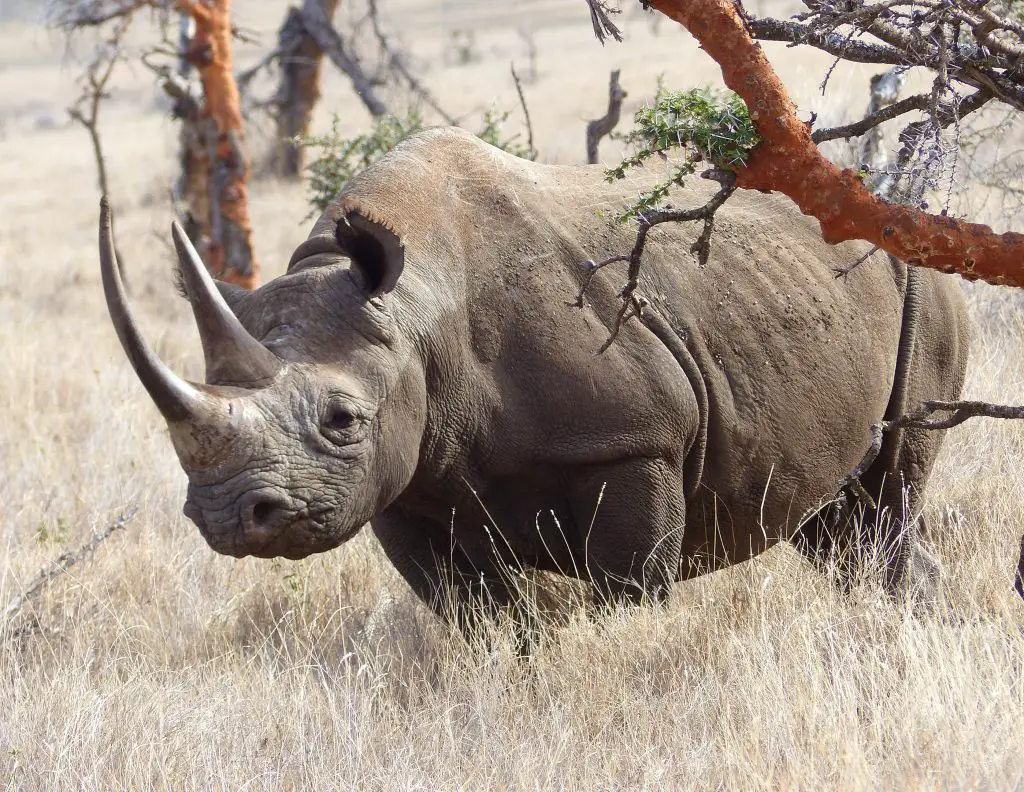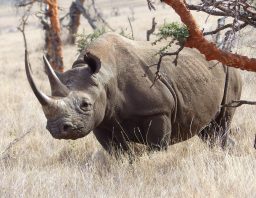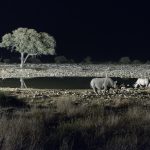All rhinos have a small amount of hair not fur. Apart from the Sumatran Rhino (also known as the hairy rhinoceros) rhinos only have hairs on their ears and tail.

Do Rhinos Have Hair Or Fur?
Rhinos do not have fur. They have evolved from a family of mammals whose surviving species evolved away from fur as a protective layer and moved towards thickened skin and a change of lifestyle. There have been over 50 different species of rhino in the past – some even living in North America and around the Caribbean.
Modern rhinos have created a type of skin that is made up of a lattice of collagen (a structural protein) which forms a strong protective layer – sometimes up to 5cm (2 inches) thick. This not only protects their body from external damage but helps protect their internal organs too – especially during fights. This thick skin replaced the layer of fur that other mammals have – including their closest living relatives – the tapirs.
Rhinos do however have a tiny amount of residual hair inside of the ears and on the tuft of the tail as they were too valuable to lose completely. Having hair in the ears can help keep them clean (along with oxpeckers) and increase audible senses. Having them on the tail makes for a great fly swat. They also have hairs on their upper eye-lids – eyelashes!
As a finale though, the Sumatran Rhino (Dicerorhinus sumatrensis) as a calf is covered in a very thin layer of hair – most noticeable around the face and ankles (where it can even be curly). In the distant past, rhinos were fully furred, so this may well be a carry-over from that. These rhinos had no reason to select against having hair – it gave them no disadvantage in life.
Was There A Woolly Rhino?
Not all rhinos of the past were completely hairless – this is proved so by the famous Woolly Rhino (Coelodonta antiquitatis). During the Pleistocene era, this giant rhino (about the size of the White Rhino (Ceratotherium simum)) was totally covered in a thick coat of fur from head to tail. Along with this gingery pelage to stay warm, it also had a giant shoulder hump. This was necessary to support its massive head and its 1m (3.3ft) front horn which protruded forwards (rather than upwards like a modern rhino).
Their thick coat allowed them to stay warm throughout the very cold winter across their habitat in northern Europe and Asia. They had other adaptations to cold weather too – like shorter ears and shorter legs – so as long as they stayed in this cool environment they would have been perfect.
However, the planet had other ideas. Once the Ice Ages departed for the final time, the northern hemisphere started to warm up – faster than the Woolly Rhino could evolve away from their cold-weather specialisms. Just like Woolly Mammoths, they became extinct. Their closest relative alive today is the Sumatran Rhino – so having hair didn’t cause the demise of all the prehistoric rhinos.
Why do Rhinos Have Hair on Their Ears?
Having hair in the ears can help keep them clean and increase audible senses. That and the Oxpeckers is what the Rhino relies on when it comes to cleaning their ears.
Can Rhinos Get Sunburnt?
Yes, rhinos can get sunburnt. Although they have super thick – collagen-dense skin – they can still get sunburnt. Unlike humans – where standing in the shade is the only way to prevent skin damage – rhinos have come up with a great way to protect their skin – mud.
Along with most other non-furred African mammals – they love a mud wallow.
By coating their back and body in a thick crust of sticky mud – they prevent it from burning. And that wallow is very cooling too. Also, this layer of mud acts as an insect repellent – as blood-sucking insects are attracted to heat – and when coated in mud – the insect’s heat radar gets confused. So triple protection from the same mud.
Do Foxes Prefer to Sleep in Dens or Out in the Open?
Do foxes sleep in dens or out in the open? Foxes sleep in dens, which provide them with shelter, security, and protection from predators. These natural shelters also help maintain their body temperature during cold weather. While foxes may occasionally rest in the open, dens remain their preferred choice for a peaceful slumber.
How Do Rhinos Stay Clean?
Unlike many small mammals – the rhinos can’t really groom themselves all over – so they have a few tricks up their sleeves.
Firstly – they allow in the cleaning team. African rhinos (Black and White) have a symbiotic (two-way) partnership with oxpecker birds. This means that all sorts of parasites, fungus, and other detritus are picked off by a team of hungry predators. Although the birds can be a bit annoying around the face – they are worth tolerating for a top-to-toe clean-up. The birds get an easy free meal – and the rhinos get rid of those pesky pests.
Second – Rhinos also love a dunk in a stream or river – in fact, the Indian, Sumatran, and Javan rhinos spend quite a lot of time in the water. In their jungle habitats, they are constantly crossing waterways and getting a cooling soak and additional mud bath whenever they can. No doubt the regular rain showers – and rubbing through thick vegetation – can also help keep the skin in good shape.










